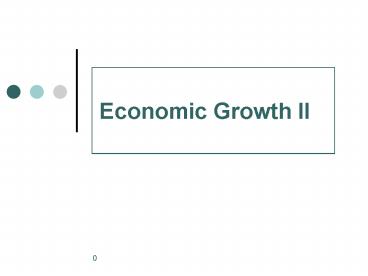Mankiw 5e Chapter 8: Economic Growth II - PowerPoint PPT Presentation
1 / 29
Title:
Mankiw 5e Chapter 8: Economic Growth II
Description:
Solow model so far cannot explain long-run sustained growth in living standards ... initially low (low k implies low MPL labor abundant relative to capital) ... – PowerPoint PPT presentation
Number of Views:874
Avg rating:3.0/5.0
Title: Mankiw 5e Chapter 8: Economic Growth II
1
Economic Growth II
2
Introduction
- In steady state, output per worker is constant
- Solow model so far cannot explain long-run
sustained growth in living standards - This lecture add change in technology to try to
account for these facts
3
Technology Progress
- Rewrite the production function to incorporate
technology change - E efficiency of labor
- E ? L effective workers
4
Technology Progress
- Assume that E grows at rate g
- Therefore E ? L grows at rate n g
- Redefine all variables in terms of effective
workers - k K/EL capital per effective worker
5
Technology Progress
- Then y Y/EL ( output per effective worker) is
given by - Similarly for consumption and investment
6
Technology Progress
- Therefore, the equations are the same as before
- The only change is in the law of motion for k.
Capital per effective worker - Increases with investment
- Decreases with physical depreciation
- Also decreases because there are more effective
workers to share the existing capital (higher L
and E)
7
Technology Progress
- Then
- In steady-state, capital per effective worker is
fixed
8
Technology Progress
(? ng)k
sf(k)
k
k2
k
k1
9
Technology Progress
- In steady state, income, consumption and
investment per effective worker are also constant
over time
10
Technology Progress
- Therefore capital, income, consumption and
investment per worker grow at the rate g in
steady-state
11
Technology Progress
- This follows since steady-state variables are
constant and E is growing at the rate g - Therefore, the inclusion of technology progress
in the Solow model can generate sustained
long-run growth
12
Technology Progress
- Moreover, total capital, output, consumption and
investment grow at the rate ng in steady state - Given that steady-state variables are constant
and EL is growing at the rate ng
13
Golden Rule
- Consumption per effective worker in steady state
- Golden Rule find k s.t. c is maximized
14
Factor Prices
- So far, we solved the model without any reference
to wages and rental rates (factor prices) - We just focused on how income is generated, but
not on how it is distributed - Assume that a competitive firm hires capital and
labor to generate output
15
Factor Prices
- Assuming Cobb-Douglas technology
- Then the problem for this firm is given by
16
Factor Prices
- First-order condition for K implies that
- In steady-state, the real rental rate is fixed
(since k is fixed)
17
Factor Prices
- First-order condition for L implies that
- In steady-state, the real wages increase at the
rate g (since k is fixed and E grows at the rate
g)
18
Factor Prices
- Assume that capital is initially below the
steady-state. Then k will evolve according to the
following path
k
k
t
19
Factor Prices
- Rental rate
- initially high (low k implies high MPK)
- decreases over time as capital accumulates and
MPK decreases
R/P
t
20
Factor Prices
- Define wage in terms of efficiency units as
- Then
- initially low (low k implies low MPL ? labor
abundant relative to capital) - increases over time as capital accumulates and
MPL increases - constant in steady state
21
Factor Prices
- This means that real wages (w/P)
- Grow faster than g during the transition
- Grow at the rate g in steady-state
t
22
Sources of Economic Growth
- Assume Cobb-Douglas Production Function
- Take log and differentiating
23
Growth Accounting in US
24
What is z
- Human Capital (Education)
- Technological Progress
- Externality environmental Issues
- Institutional Effect
- Firm Organization
- Patient Protection
- Corruptions
25
Policies to promote growth
- Saving Rate
- Human capital investment
- Encouraging technological progress
- Right Institutions
26
Growth empirics Confronting the Solow model
with the facts
- Solow models steady state exhibits balanced
growth - many variables grow at the same rate. - Solow model predicts Y/L and K/L grow at same
rate (g), so that K/Y should be constant. - This is true in the real world.
- Solow model predicts real wage grows at same rate
as Y/L, while real rental price is constant. - Also true in the real world.
27
Convergence
- Solow model predicts that, other things equal,
poor countries (with lower Y/L and K/L )
should grow faster than rich ones. - If true, then the income gap between rich poor
countries would shrink over time, and living
standards converge. - In real world, many poor countries do NOT grow
faster than rich ones. Does this mean the Solow
model fails?
28
Convergence
- No, because other things arent equal.
- In samples of countries with similar savings
pop. growth rates, income gaps shrink about
2/year. - In larger samples, if one controls for
differences in saving, population growth, and
human capital, incomes converge by about 2/year.
29
Convergence
- What the Solow model really predicts is
conditional convergence - countries converge to
their own steady states, which are determined by
saving, population growth, and education. And
this prediction comes true in the real world.































